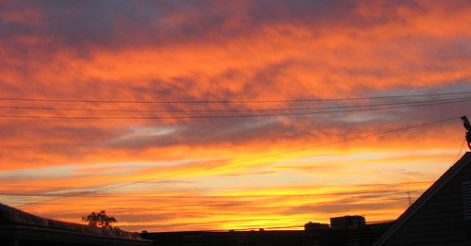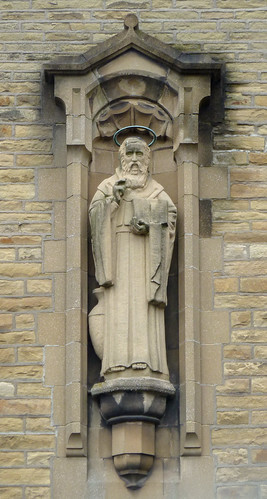
 )
)If you want to read about some science that has nothing to do with our current situation, may I suggest a story about vocal cooperation among dolphins or some fruit fly research revealing just how versatile proteins can be. Meanwhile, many Christians around the world face the prospect of celebrating Easter in isolation in one of the more practical and large scale intersections of science and religion I can recall. That seems to merit some comment. (And I promise, next week nothing virus-related.)
I recently had to buy a graphing calculator for my son, which reminded me of being in high school and programming my own TI-83 to calculate the date of Easter given the year. I didn’t work out the logic myself; I was simply implementing an algorithm I came across. I think it appealed to me as an exercise because it was complicated enough to not be a trivial program, but not so involved that it became too tedious to type on a calculator keypad. Given how simple it is to work out the dates of most holidays, the Easter dating process is remarkably involved, depending on the interplay of both lunar and solar cycles. Still, we understand those cycles well enough–and the cycles themselves are regular enough–that we can work out Easter millenia in advance (this table sketches out the math, if not the exact dates, until 4099).
Our current level of precision in predicting celestial movements took centuries to develop. Even after shifting to a heliocentric model with elliptical orbits based on gravitational forces, predictions in the era of Newton eventually became irrecoverably unstable, a problem some physicists solved by simply presuming God would nudge the planets back into proper orbits as needed. A century after Newton, Pierre-Simon Laplace had worked out a more refined model which remained stable far longer. The story goes that Napoleon read Laplace’s work and asked him where God was in the whole arrangement, to which Laplace replied that he had no need of that hypothesis. Often quoted in support of the idea that science erodes a belief in God, Laplace may simply have been saying that his math required no miraculous interventions; he may still have allowed for God’s sustaining providence as the ultimate cause of the movements described by his math.

 )
)We now find ourselves about to celebrate Easter on April 12, a date Laplace likely could have worked out ~250 years in advance. But we will do so separately in our homes as we try to limit the spread of a virus that might have been broadly anticipated by some but certainly not predicted to be keeping us isolated on this particular holiday. The physical world is not uniformly predictable, and developments in mathematics and physics since Laplace have tempered our confidence even in those disciplines. We no longer think, as Laplace did, that someone with full knowledge of where everything is in the universe and of the laws of physics could work out where everything was in the past and where it will be in the future. Now we don’t even know when we will be in church again.
In such unpredictable times it is natural to think about faith and trust and where to place it. I know it might seem like we are trusting science & scientists right now when maybe we could take a bold step of faith in God to protect us. But I think we can still take some advice from astronomers who did the work that allows us to know when to celebrate Easter. Consider for example the words of astronomer Johannes Kepler: “Those laws [of nature] are within the grasp of the human mind; God wanted us to recognize them by creating us after his own image so that we could share in his own thoughts.” Kepler trusted his own observations and investigations, as well as those of his fellow astronomers, to reveal truth about God and from God. But really he was trusting God–trusting him to make a world that has regularities and consistencies that can be understood, and trusting him to make people with the faculties to discover and appreciate those consistencies.
I believe both of those principles still hold true, even if our present understanding is incomplete and not always as mathematically precise as we might wish. While we may not know everything about this virus and how it will spread, that doesn’t mean we know nothing. Once an outbreak starts, it does follow recognizable patterns and respond to known control measures. Some of the particulars depend on the biology of the specific virus, biology which we are learning at an astounding and unprecedented pace. When guidelines like the recommendations of masks change, it is not because we never really understood masks but because we updated our model with a more detailed appreciation of how this virus interacts with them.
And where uncertainty remains, we can apply the wisdom of another scholar who worked on calculating Easter: Bede the Venerable. Bede wrote “He alone loves the Creator perfectly who manifests a pure love for his neighbor.” We do not know perfectly where the virus is right now, and so we will be partially wrong about where it will be in the future. If we must be wrong, let’s err on the side of loving our neighbor. In this moment, for many of us caring means not sharing–counterintuitive, I know, but then science often is. Just ask folks like Kepler who suggested that the Earth, contrary to everyday experience, moves. And who knew that you’d be observing Easter this Sunday before you were even born.
Andy has worn many hats in his life. He knows this is a dreadfully clichéd notion, but since it is also literally true he uses it anyway. Among his current metaphorical hats: husband of one wife, father of two teenagers, reader of science fiction and science fact, enthusiast of contemporary symphonic music, and chief science officer. Previous metaphorical hats include: comp bio postdoc, molecular biology grad student, InterVarsity chapter president (that one came with a literal hat), music store clerk, house painter, and mosquito trapper. Among his more unique literal hats: British bobby, captain’s hats (of varying levels of authenticity) of several specific vessels, a deerstalker from 221B Baker St, and a railroad engineer’s cap. His monthly Science in Review is drawn from his weekly Science Corner posts — Wednesdays, 8am (Eastern) on the Emerging Scholars Network Blog. His book Faith across the Multiverse is available from Hendrickson.

Leave a Reply